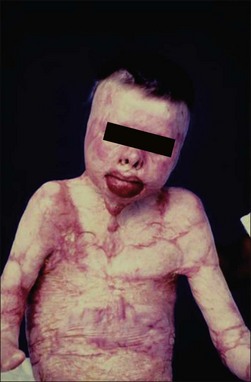Chapter 62 Functional sequelae and disability assessment
![]() Access the complete reference list online at http://www.expertconsult.com
Access the complete reference list online at http://www.expertconsult.com
Introduction
Advances in acute burn care during the past 25 years, in terms of decreased mortality and decreased length of hospital stay, have been truly outstanding and amazing. In 1971, survival statistics at the Institute of Surgical Research in San Antonio demonstrated an LD50 (lethal dose resulting in a 50% survival rate) with approximately 40% TBSA (total body surface area) burn. Thus 50% of the patients with burns of only 40% died. Now, the LD50 approaches 80% TBSA, and, if no inhalation injury is involved, patients with burn injuries greater than 80–90% of their TBSA routinely survive. In almost every burn unit in the United States, the length of stay has decreased from nearly 3 days/% burn to less than 1 day/% burn. The success can be stated simply: patients with larger, more severe burns are surviving; however, are these patients returning to society to become productive citizens? What is the real outcome of massively burned patients? Do pediatric burned patients become functional adults? How do they function socially later in life? What is the long-term effect on the patient’s families and society? Are survival and decreased length of stay really the measure of productivity for our specialty? The real product or measurements of customer service is a patient who can successfully return to society and, even more importantly, be a useful, productive individual who can successfully interact socially within a community. Yes, patients with larger and more severe burns are surviving, but this has created new problems for patients’ quality of life. Although the problems are magnified in massively burned patients, they exist even in smaller burns. These problems are best demonstrated in a pediatric burn patient with a 95% TBSA burn (Fig. 62.1). Cultured keratinocytes were utilized to achieve wound coverage. The child survived; however, when we examined the patient’s current and future reconstructive needs, they totaled 33 potential reconstructive procedures. Thus, the reconstructive problems are monumental in a child with very few donor sites.1 With regard to survival, the results of this patient are impressive; however, we must ask the question: ‘Has the medical expertise in terms of survival progressed past the ability to reconstruct and rehabilitate patients?’ Unfortunately, the answer is clearly ‘yes’. Are we returning our patients to a society which is not ready financially, psychologically, or socially, to accept them? Again, unfortunately, the answer is clearly ‘yes’.
Basic considerations: impairment, disability, handicap
‘Impairment’ refers to an alteration of an individual’s physiological, psychological, and anatomical structure or function that interferes with activities of daily living or a significant deviation, loss, or loss of use of any body structure or body function in an individual with a health condition, disorder, or disease.2
’Disability’, which is assessed by non-medical means, means an alteration in an individual’s capacity to meet personal, social, or occupational demands or to meet statutory or regulatory requirements or activity limitations and/or participation restrictions in an individual with a health condition, disorder, or disease.2 Simply stated, impairment is what is wrong with the health of an individual; disability is a gap between what the individual can do and what the individual needs or wants to do. An individual who is impaired is not necessarily disabled. Impairment gives rise to disability only when the medical condition limits the individual’s capacity to meet the demands which pertain to non-medical fields and activities. On the other hand, if an individual is able to meet a particular set of demands, the individual is not disabled with respect to those demands, even though a medical evaluation may reveal impairment.




